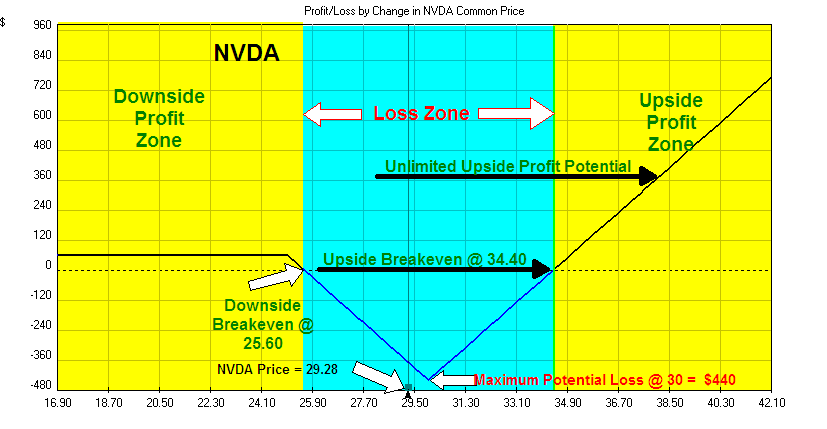Using options to play the breakout pullback in NVDA
When breakouts occur, it sometimes pays to wait for a pullback.
NVIDIA Corporation (NVDA), which designs, develops and markets graphics
processors software for use in personal computers and digital entertainment
platforms broke out on August 12 from a classic ‘cup with handle’ formation. The
stock has relative strength of 90 and an excellent technical and fundamental
profile. If you believe the pullback to 29.28 (as of Thursday’s close, just
below its breakout price of 29.30) is temporary, this may be an excellent point
to get on board for a potential ride higher.
This is a reasonably good set-up for a December call backspread.
As you can see in Figure 1, the breakout has stalled and pulled back to just
above a chart gap. This is a lower risk entry in a breakout, since we get in at
little better price. Unfortunately, not all breakouts pull back, and not all
pullbacks resume the move higher. That is why I like backspreads.

Figure 1 — Generated Using OptionVue 5 Options Analysis Software
There is potential for unlimited upside profit, yet if the breakout fails, it
may fall far enough to land in a small profit zone on the downside. The worst
case scenario, of course, is for the stock to stall and move sideways over the
course of the trade. But using a December call spread minimizes this since in
the next several months the stock will likely resolve one way or the other.
Figure 2 contains the details of the December call backspread. As you can see,
we could get about $500 for the sale of the in-the-money December 25 call (the
underlying price is at 29.34), and we would need to pay about $440 for two of
the December 30 calls. This leaves a net credit of $60, which after commissions
would be our potential downside profit if we fell low enough.
Figure 3 shows that breakeven on the downside is at 25.60, just above the short
strike. Meanwhile, we would need to move above 34.40 to get into a profit zone
on the upside.

In between these prices would be losses, with maximum potential loss, if nothing
were done to adjust the trade, at $440 (not counting commissions).

Figure 3 — Generated Using OptionVue 5 Options Analysis Software
One advantage to using a call backspread for a breakout trade is that the
maximum loss is limited on the downside should the stock tank, although in this
particular backspread, the maximum loss would be higher than an 8% stop loss
placed below the entry price on a long stock position (this is not always the
case, as I have shown in previous articles).
Nevertheless, we could set a maximum stop loss on the spread equivalent to the
8% stop loss value on a long position, which would be $238. While this is a net
credit trade, it is not time-value friendly, so no movement of the stock will
slowly eat into the position, resulting in unrealized losses.
Hope this gives you some trading ideas ahead of the weekend.
Cheers!
John Summa
Past performance is not a guarantee of future profit. Options may not be
suitable for all traders. Trade with risk capital only.
John F. Summa is Founder and President of
OptionsNerd.com,
and a registered Commodity Trading Advisor (CTA) with the National Futures
Association (NFA). Founded in 1998, OptionsNerd.com offers trading
seminars and tutorials to options traders, futures and option trading
advisories and managed futures and options CTA account services.
Mr
Summa’s trading articles have appeared in Technical Analysis of Stocks &
Commodities magazine, as well as Active Trader Magazine, Options Trader
Magazine, Futures Magazine, Stock, Futures & Options Magazine, and Investopedia.com. He coauthored
Options on Futures: New
Trading Strategies and Options on Futures Workbook (John Wiley & Sons, 2001) and more recently wrote the groundbreaking
book,
Trading
Against The Crowd: Profiting From Fear and Greed in Stock, Futures and
Options Markets (John Wiley & Sons,
2004), which includes Mr. Summa’s innovative quantitative bear and bull
news-flow Contrarian indicator. Mr. Summa is a PhD-trained economist
and operates a
delta-neutral options trading CTA program.
Attend John’s Upcoming Seminar:
To learn how to trade options correctly, visit John’s website,
OptionsNerd.com! He offers free and
premium options education seminars, as well as an equity index options spread
trading advisory. John will be presenting his next intensive options seminar in
Chicago on September 23, 2005. To learn more about this event, please
click here
for more info.
